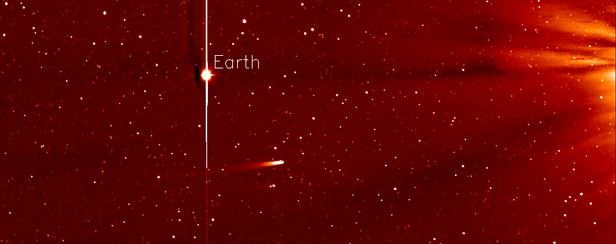Dramatic fading of ISON's molecular emission lines

The team at IRAM millimeter telescope, Spain, reported today that they see consistent rapid fading of ISON's molecular emission lines. The fading was recorded between November 21 and 25 by at least a factor of 20 (likely more).
Their report concludes that the fading may indicate that the nucleus is now at best marginally active or that… it no longer exists. (Source)
Latest CIOC update (November 25, 2013):
"We are seeing reports online that molecular emission from the comet has fallen dramatically, meanwhile dust production seems to be enormous. What this could indicate is that the nucleus has completely disrupted, releasing an enormous volume of dust while significantly reducing emission rates. Fragmentation or disruption of the nucleus has always been the highest risk factor for this comet so if this has indeed happened then while unfortunate, it would not be a surprise.
However, these reports are new, and while they are undoubtedly valid, we do still need to keep observing the comet to be sure what it happening. Remember: Comet ISON is a dynamically new sungrazing comet, fresh in from the Oort Cloud, and the last time we saw an object like this was never! Furthermore, a sungrazing comet just three days from perihelion has never been studied in this kind of detail – we're breaking new ground here! When we factor in your standard "comets are unpredictable" disclaimer, what we have is a huge recipe for the unknown.
Accordingly, we urge observing teams to factor in the changing nature of comet ISON, and attempt to obtain all data they can and share those with us so that we can keep the community informed. We appreciate that observing ISON now is extremely challenging as it is only three days from perihelion. Comet ISON is now very much in the realm of the solar observing fleet, and indeed the NASA STEREO-A spacecraft is returning some amazing views of both comets ISON and Encke.
To keep up to date on the latest reports from professional observers, we recommend you regularly check our Observation Logs page, which you can find under the "Observing" tab, above. Also, we have once again updated our light-curve with new observations.
Today's tl;dr is perhaps a little worrying. Reports of dramatic changes in comet ISON's dust and molecular emission rates may possibly be an indication that the nucleus has disrupted. We may not know for sure until ISON reaches (and hopefully) passes perihelion, though complete disruption – if that is indeed the case – would lead us to think that survival may be unlikely. In three days' time, we'll know…"
Update – November 26, 2013
Jakub Černý:
No good news from STEREO-A. Matthew Knight has sent me his photometry of spacecraft images to 15UT 25. Nov. They well corresponds to latest visual observations. After strong fade, comet has started to gaining brightness again. Unfortunately with speed far bellow (n=0.66) brightening for simple reflecting body (n=2). If we assume that all brightness coming from dust cloud, there is nothing inside coma that can resupply dust to coma at least on same level. What is worst, deviation from average activity level keep growing. Such characteristic more corresponds to slowly scattering dust cloud, then intact comet.
http://www.kommet.cz/datas/users/ison-lc-perv2_1.png
Best regards,
Jakub Cerny
.gif)
STEREO Ahead HI1 image show Comet ISON at 12:49 UTC on November 26, 2013. Comet ISON looks pretty intact. (Credit: NASA/STEREO)
Matthew Knight (Lowell Obs.) measured the comet with the STEREO A spacecraft's HI-1 instrument:
ISON has continued to brighten in the STEREO-HI1A images over the last 36 hr. As of Nov 26.54 it is approximately a V magnitude of 3.9 in an 11.7 arcmin diameter aperture. Just looking at the lightcurve by eye suggests that there may have been an outburst from roughly Nov 20-22 which was superposed on a steadily brightening curve
Featured image: Comet ISON and Encke on November 25, 2013. Image credit NASA/STEREO

It is amazing about the comet. Everyone hair rises their comments and try to study something they really do not know about. I have been studying this and it is amazing the different stories from both scientist and people who are just giving their own opinion. Everyone is different. Amazing. Yet through this we forget that God is in charge no matter what we think or believe. All I could say is get ready because even if Ison is not the comet to produce disaster on earth. You could bet on this one as in Revelation 8:10 that a great star blazing will hit the earth and destroy. So it is coming and the world needs to prepare regardless of what you think. Anyone who does not cannot comment on anything unless they can prove the Word of God does not exist.
Huge amount of dust…these are bad news….we MUST prepare for late december and first two weeks of january, we will pass through all this dust and only God knows what will happen…perhaps these dust pieces aren't as tiny as NASA predicted, how could they know the size of the pieces desintegrated…we may have a meteorite rain and dark red sky because this dust will obscure day light…''three days of darkeness'',prepare spiritually and have some extra food and water.
ISON is too high up for its dust to touch us.
http://i.imgur.com/SmoZTKd.jpg
If ISON does disintegrate, the chunks will continue to follow the orbit.
I hope so, but some questions still remain: can earth gravity have some effects on these chunks, pulling them around?can anything unexpectedly change their course, like a CME blast from the sun? …strange times indeed…